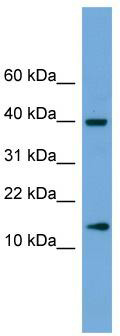ATP6V1G2 Rabbit Polyclonal Antibody
Frequently bought together (1)
Other products for "ATP6V1G2"
Specifications
| Product Data | |
| Applications | WB |
| Recommended Dilution | WB |
| Reactivities | Human |
| Host | Rabbit |
| Isotype | IgG |
| Clonality | Polyclonal |
| Immunogen | The immunogen for anti-ATP6V1G2 antibody: synthetic peptide directed towards the middle region of human ATP6V1G2. Synthetic peptide located within the following region: NLSAEVEQATRRQVQGMQSSQQRNRERVLAQLLGMVCDVRPQVHPNYRIS |
| Formulation | Liquid. Purified antibody supplied in 1x PBS buffer with 0.09% (w/v) sodium azide and 2% sucrose. Note that this product is shipped as lyophilized powder to China customers. |
| Purification | Affinity Purified |
| Conjugation | Unconjugated |
| Storage | Store at -20°C as received. |
| Stability | Stable for 12 months from date of receipt. |
| Predicted Protein Size | 13 kDa |
| Gene Name | ATPase H+ transporting V1 subunit G2 |
| Database Link | |
| Background | This gene encodes a component of vacuolar ATPase (V-ATPase), a multisubunit enzyme that mediates acidification of intracellular compartments of eukaryotic cells. V-ATPase dependent acidification is necessary for such intracellular processes as protein sorting, zymogen activation, receptor-mediated endocytosis, and synaptic vesicle proton gradient generation. V-ATPase is composed of a cytosolic V1 domain and a transmembrane V0 domain. The V1 domain consists of three A and three B subunits, two G subunits plus the C, D, E, F, and H subunits. The V1 domain contains the ATP catalytic site. The V0 domain consists of five different subunits: a, c, c', c'', and d. Additional isoforms of many of the V1 and V0 subunit proteins are encoded by multiple genes or alternatively spliced transcript variants. This encoded protein is one of three V1 domain G subunit proteins. This gene had previous gene symbols of ATP6G and ATP6G2. Alternatively spliced transcript variants encoding different isoforms have been described. |
| Synonyms | ATP6G; ATP6G2; NG38; VMA10 |
| Note | Immunogen Sequence Homology: Dog: 100%; Rat: 100%; Human: 100%; Pig: 93%; Mouse: 93%; Sheep: 93%; Bovine: 93%; Rabbit: 93%; Horse: 86%; Guinea pig: 86% |
| Reference Data | |
| Protein Pathways | Epithelial cell signaling in Helicobacter pylori infection, Metabolic pathways, Oxidative phosphorylation, Vibrio cholerae infection |
Documents
| Product Manuals |
| FAQs |
| SDS |
{0} Product Review(s)
0 Product Review(s)
Submit review
Be the first one to submit a review
Product Citations
*Delivery time may vary from web posted schedule. Occasional delays may occur due to unforeseen
complexities in the preparation of your product. International customers may expect an additional 1-2 weeks
in shipping.






























































































































































































































































 Germany
Germany
 Japan
Japan
 United Kingdom
United Kingdom
 China
China



